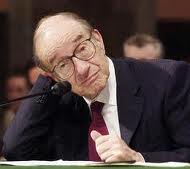 Continuing the theme of ironic historic statements in the light of present circumstances explored in Life After Debt Part I,[1] today’s bizarro world villain is Alan Greenspan.
Continuing the theme of ironic historic statements in the light of present circumstances explored in Life After Debt Part I,[1] today’s bizarro world villain is Alan Greenspan.
No other financial celebrity (with the possible exception of Warren Buffet) carried more weight a decade ago than then-Federal Reserve Chairman Greenspan. So when he said in 2001…
The most recent projections from OMB and CBO indicate that, if current policies remain in place, the total unified surplus will reach about $800 billion in fiscal year 2010, including an on-budget surplus of almost $500 billion. Moreover, the admittedly quite uncertain long-term budget exercises released by the CBO last October maintain an implicit on-budget surplus under baseline assumptions well past 2030… Indeed, in almost any credible baseline scenario, short of a major and prolonged economic contraction, the full benefits of debt reduction are now achieved well before the end of this decade — a prospect that did not seem reasonable only a year or even six months ago. Thus, the emerging key fiscal policy need is now to address the implications of maintaining surpluses beyond the point at which publicly held debt is effectively eliminated.[2]
… people listened.
And what they heard from Greenspan in 2001 was, “we deserve a tax break” given the impending massive federal surpluses. Greenspan further went on to warn us of the problems of investing the federal surplus, just as the economists at Treasury had worried about in the ‘Life After Debt’ memo.
When I read this, even eleven years later, my face tightens up and my lips curl outward and my stomach gathers into a little tiny ball and I just start spitting f-bombs at Greenspan’s image on the computer screen. The way he used his financial celebrity and political capital in 2001 drives me bonkers.
Now, I know the world is too complicated to blame all of our problems on the heads of a few individuals or institutions, and especially on the head of one person. But, if I was forced to name the biggest enabler of our country’s shift in the past decade from surplus to deficit, from creditor to debtor, from strength to weakness, from leader to follower, I’d pick that guy.
If only he’d used his powers for good instead of evil.
[1] Also, please read related posts Life After Debt Part II and Life After Debt Part III
[2] If Greenspan’s bureaucraticoeconomicspeak needs translation, he’s saying something like: “The government’s statistics office says we’ll have a federal surplus by 2010, which will continue to grow, under reasonable assumptions, through 2030. We just realized this 6 months ago. Now the big issue to worry about is what to do with our surpluses.”
Post read (1364) times.

